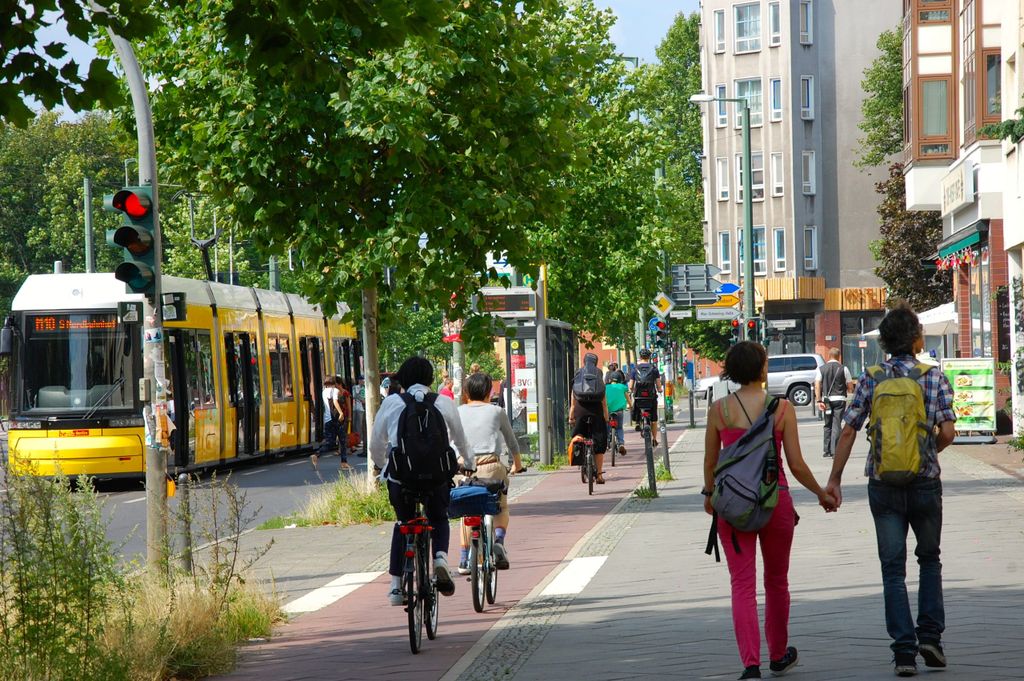
How shared mobility solutions can improve our cities and towns
5 ways shared mobility is changing the way we travel
Mass transit cannot fulfil every single mobility need. Some places are too sparsely populated, some hours are too low in demand. At the same time, we can’t rely on private cars to get us around where high-capacity public transport is unable.
For one, petrol cars are heavy polluters. But even electric cars take up huge amounts of valuable public space and impose a financial barrier to mobility on low-income persons. Instead, shared transportation can help plug the gaps in a more sustainable, equitable, and beneficial way.
Shared transportation has unique qualities, and that gives the sector the potential to replace privately owned cars where public transport is less able. Shared mobility services, like ride-hailing, car sharing, e-scooters, and shared bikes, offer more flexible ways of travelling from conventional public transport.
This has become clear to authorities and public transport operators who are increasingly turning to shared mobility solutions. To illustrate how fast the sector is growing, in 2017, only one mobility company was worth more than €1 billion. But today, there are 15 European mobility companies valued over €1 billion!
Accessibility
Naturally, shared services are more affordable than privately owned ones. At the same time, shared mobility can operate in areas and at times that are less cost-effective for traditional public transport modes, for instance because of low demand.
Building on that, when shared mobility services are connected to key hubs with public transport options – a part of what we call combined mobility – we can greatly extend the equity and accessibility of mass transit networks. In addition, the point-to-point nature of on-demand services makes them invaluable for those in need of extra assistance.

Convenience
Nobody likes to wait, especially if it is an unexpected and unpredictable delay. That’s where shared mobility services come in useful, because these apps can leverage their own data to make waiting both expected and predictable – if passengers need to wait at all.
With some shared transportation services, customers simply pick a vehicle and go, maximising in-vehicle time. And studies show that passengers prefer in-vehicle time to walking, waiting, and transferring. To fully replace the ease of privately owned cars, the opportunity of free-floating and on-demand mobility must be taken into consideration.
“We know from our micromobility operations that if you have a distance over 150 metres to walk to the nearest parking spot or available vehicle, then people start to think about other modes of travelling.”
Door-to-door journeys
Shared mobility services make it easier for us to plan, route, and book our journeys. And on-demand mobility services, shared cars, and dockless shared micromobility can pick up and drop passengers closer to their destination than conventional public transport can.
This is especially important, to name a few examples, for journeys at night, with children, when moving heavy items, and, as mentioned, for those in need of extra assistance. This last point is likely to gain in relevance, with populations aging fast around the globe.
Want more insights on the future of shared mobility? Watch our expert webinar!
First/last mile
A journey’s attraction is determined by the weakest link in the chain.
Often, that’s the “first or last mile” of a trip. Essentially, the distance between the origin/destination and the closest convenient public transport stop. Because shared mobility can be free-floating, without fixed routes, and simply requested on-demand, it has a great effect on the first/last mile of a journey. And when these services are integrated into the public transport network, mass transit becomes a much more accessible and attractive option.

Time flexibility
Sometimes, it’s not practical to run public transport at every hour of the day. However, shared and on-demand mobility services are not tied to a fixed schedule, and so can extend operational times and improve accessibility and security, especially during vulnerable night journeys.
On this note, it’s important that private operators and public authorities work together and discuss how shared mobility solutions should contribute to the urban transport network. For example, in 2021 Oslo banned the use of shared e-scooters at night. Regulations like this can affect the viability of shared mobility services.

Efficient use of public space
Shared mobility services can enrich the mobility mix with flexible mobility options. With easier point-to-point travel at all hours of the day, we can avoid excessive car use and create cleaner, more accessible cities. If implemented well, shared transportation has a range of benefits.
About a quarter of urban space is devoted to transport. Yet studies show that over half of that is taken up solely by cars. In fact, before implementing their famous “superblocks”, 85% of Barcelona’s street surface was occupied by cars. This space is used far more efficiently by public transport and shared mobility services that don’t sit parked for 23 hours of the day like private cars do.
“In our high performing schemes, we see 5 to 6 rides per day per pedal bike, such as in Cologne or Dresden during the summer months, and up to 10 rides per day for shared e-bikes, for example, in Bilbao.”
If shared mobility can encourage a switch to multimodal mobility, using both shared transportation and public transport, there could be fewer vehicles on our streets. As noted in a UITP report, every car-sharing vehicle in Bremen, Germany replaces – or prevents the purchase of – 16 privately-owned vehicles, resulting so far in around 7,500 fewer vehicles on city roads.

Faster to implement
Public transport requires significant infrastructure. And that infrastructure can be challenging to implement when each city represents unique challenges, such as climate, demographics, and even the types of soil that the city sits on.
On this note, shared transportation is easier to introduce, and this can increase the pace of adoption, shifting people away from their private cars faster. For instance, shared mobility services like ride-hailing apps can use existing road infrastructure, whereas many shared bikes and shared e-scooters are dockless.

Higher occupancy rates
Private car occupancy rates have been declining for decades. In short, what once was a family travelling by car, is now a single passenger. At the same time, urbanisation has moved billions into cities, where we cannot afford to waste valuable space. That makes it imperative for cities and towns to implement shared mobility solutions, where more passengers can be pooled together in the same vehicle.
Lower carbon emissions
Shared mobility can greatly lower carbon emissions – if it is integrated into the existing public transport network. That way, it can replace car journeys, and not walking and cycling trips. With coordinated urban planning and a modal shift away from private cars, combined mobility can reduce emissions by 34%. That would cut 10% of all urban emissions!
Modal shift to public transport
Research finds that around 63% of riders combine shared e-scooter trips with public transport. Indeed, shared mobility services can act as a feeder network for high-capacity public transport such as metro or rail lines. That makes mass transit more accessible and can encourage the use of public transport – the most sustainable and efficient way to travel.

“Our data shows that half of all journeys for the free-floating bike sharing scheme start at or stop near train and underground stations.”
Reduce car dependency
Many of the challenges that cities and towns face today are a result of an overdependence of cars. To address this issue, shared mobility services and public transport can work together to provide alternatives to the car. As well, it’s important that cities allocate more space to walking, cycling, public transport, and shared mobility. All in all, this will create quieter, cleaner cities with less congestion.
The next steps
The old way of doing things simply doesn’t cut it anymore. Instead of having each mode of transport run separately, they need to work together. However, some significant challenges lie ahead, which public-private partnerships have the power to face.
Better infrastructure
That’s tangible and digital. It has to be easier to plan, route, and book multimodal travel. To be sure, the easier it is to use shared transportation at the same time as public transport, the more people will choose it. On the other hand, people will pick their private car if they are asked to navigate multiple mobile apps and badly designed modal transfers.
“It is important to understand that every trip does not start at a station, but often on a smartphone or a laptop.”
Combined mobility
To maximise the benefits of shared mobility services, cities and towns must work with private operators and integrate them with public transport. That way we can limit inefficiencies, reduce negative outcomes, and develop a holistic mobility strategy that minimises car use.
Profitability & sustainable revenue models
So far, shared mobility services have grown fast by emphasising market share over profit. Indeed, only in 2022 did the first micromobility company experience a full profitable year. But the sector cannot rely only on venture capital to sustain itself in the long-term, nor can it raise prices so high that private cars are the cheaper option.
Fortunately, shared transportation can generate much of its own revenue through fares, more so than traditional public transport in fact. This is called user income coverage, in other words, how much revenue users bring in compared to the cost of operations. That means shared mobility solutions are less likely to rely on public money to operate. But to cover the shortfall, sustainable solutions need to be established, as mentioned by mobility expert Benoit Beroud.
“The user income coverage is around 30 to 40% for public transport. A current study of six services in Brussels finds that user income coverage for shared bikes is between 40 and 50% of the cost.”
Policy incentives; better and more informed regulation
Local authorities in cities and towns have many tools to boost the uptake of shared mobility solutions. The obvious is building infrastructure, like separated bike lines and docking stations by key mobility hubs. But this also includes smaller policy incentives, like free parking for car sharing vehicles, dedicated lanes for carpooling vehicles, as well as congestion/peak time charges on private vehicles, just to name a few.
All in all, the path to improved mobility requires informed and empowered local authorities that define and act on the most effective policies. To contribute to better policymaking, shared transportation companies can share their useful data and knowledge.

How shared mobility fits in
Things are changing fast in mobility. The next few years will see some game-changing innovations, as well as tough challenges. For authorities, the key issue is how to build cleaner, better cities with less congestion, and how shared mobility can contribute to that. But for ordinary citizens, the story stays the same – how to get from A to B in a fast, convenient way.
Will both parties get what they want?







